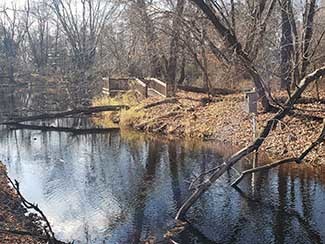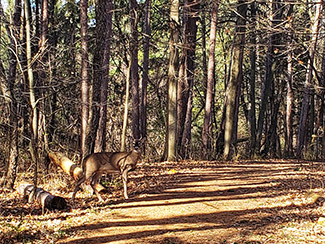Self-care Saturday is a walk in the park
By RACHEL COALE
Forest Resources Division
Michigan Department of Natural Resources
Every Saturday morning since the fall leaves began dropping, I lace up my boots, fill a water bottle and head out the door. Each week, I add another warm layer as the temperatures seem to freefall downward – a jacket, gloves, hat and thick socks.
Arriving at a local park, I reassure myself, “This is good for me,” my face reddening in the chilly winter air.

And it is – this small ritual, a dedicated time to be outdoors, has been a touchstone in a time where rapid change, uncertainty and distance from loved ones is a shared experience.
For me, the outdoors has always been a place to seek joy by jumping into lakes, rambling down ravines and finding adventure on a trail – but it’s also a place to slow down and get centered.
The buzzwordy idea of “self-care” evokes images of bubble baths, fuzzy slippers and detox drinks. But it can be simpler than that. At its most basic, self-care is a focus on physical and mental health that helps us be our best selves. For many, the outdoors is an essential part of that equation.
“The natural environment can buffer us from impacts of life stresses,” Linda E. Kruger of the Forestry Sciences Lab in Juneau, Alaska said in a talk about the importance of natural spaces for public well-being.
|

Kruger describes the forest as “nature’s health service,” emphasizing the importance of regularly spending time in the outdoors – even in winter – to physical and psychological health.
Some estimates blame more than 75% of primary care physician visits on stress-related problems; a prescription for nature may be a benefit to many. In addition to stress relief, Kruger cites research that suggests spending time in the outdoors reduces the risk of many chronic conditions.
In a study in Japan, anticancer proteins increased in the blood of participants who made short visits to forests for three days.
In many ways, my hikes in the forest or loops around the local park path are a movement meditation that engages the senses and encourages me to focus on being present.
On a trail, my to-do list falls away as I listen to the steady rhythm of my footsteps, smell rich fallen leaves and drink in the rough edges, curves and colors of nature with my eyes.
|

I once read that nature, for the most part, does not make straight lines, and it has stuck with me since. Outside, I can get away from the rectangles and boxes of indoor life.
The bend of a path, twisted trunk of a tree or ripples on a pond are soothing counters to the glaring blue screens of the phones and computers I’m parked in front of for much of the day.
With shorter days and a loss of light at what I consider the absurd hour of 5 p.m., I’ve been increasingly seeking local parks to squeeze in some outdoor time between the edge of the workday and sunset.
I love the sprawling wildness of state forests, parks and game areas, but I am also growing an appreciation for smaller green spaces closer to home.
At Fenner Nature Center, a 134-acre park wedged between Michigan State University and downtown Lansing, I enjoy visits to a native prairie, rippling ponds and forested wetlands.
White-tailed deer, muskrats and pileated woodpeckers often make appearances as I explore the trails. Surrounded by swaying trees and birdsong, it’s easy to forget that traffic lights and lattes are just minutes away.
|

“Thankfully, the outdoors have remained ‘open’ for all and will continue to provide opportunities for people to ‘get out and do something’ while so many of our favorite activities and venues are canceled or closed,” said Michigan Department of Natural Resources Marketing and Outreach Division Chief Kristin Phillips. “We are blessed in Michigan to have millions of acres of forests, thousands of miles of trails and rivers, hundreds of parks and green spaces that provide a vast amount of options – socially distant and close to home.”
Looking for a new place to get outside? Visit the Your Local Outdoors interactive map to find DNR-managed parks, trails and hunting areas close by, and visit your city, township or county’s webpages to find local parks.
This weekend, I’m looking forward to a self-care routine that will involve a hike on a new-to-me trail, a mug of hot cocoa and time spent birdwatching. But I’m not ruling out a bubble bath, either.
|

Exercise and fresh air in the outdoors are proven natural mood boosters that can help shake a case of the winter blues. However, if you find yourself experiencing serious depression symptoms, contact your doctor or call the National Suicide Prevention Lifeline for confidential support at 1-800-273-TALK (8255).
|
Check out previous Showcasing the DNR stories in our archive at Michigan.gov/DNRStories. To subscribe to upcoming Showcasing articles, sign up for free email delivery at Michigan.gov/DNR.
/Note to editors: Contact: John Pepin, Showcasing the DNR series editor, 906-226-1352. Accompanying photos and a text-only version of this story are available below for download. Caption information follows. Credit Michigan Department of Natural Resources, unless otherwise noted.
Text-only Version - Showcasing - Parks and Nature
Aging: The sawed end of an aging log is show at Sleepy Hollow State Park in Clinton County.
Autumn: An autumn trail is pictured from Lake Lansing Park North in Ingham County.
Birch: A white birch pictured against a blue autumn sky is shown from Lake Lansing Park North in Ingham County.
Deer: A white-tailed deer gets ready to cross a dirt road at the Fenner Nature Center in Lansing.
Fallen: Fallen oak loaves are shown from Sleepy Hollow State Park in Clinton County.
Garter: A garter snake enjoys a sunny afternoon.
Muskrat: A muskrat swims off with a pond plant in its mouth.
Pond: A pond, observation deck and wood duck nesting box at the Fenner Nature Center in Lansing.
Rachel: Rachel Coale, the author of this article from the Michigan Department of Natural Resources Forest Resources Division, is shown on a hike at Lake Lansing Park North in Lansing.
Stump: An old stump helps provide a picturesque setting for the Woldumar Nature Center in Lansing.
Trail: A paved trail is shown from Granger Meadows Park in DeWitt Township in Ingham County.
Trail sign: A trail sign is shown at the Fenner Nature Center in Lansing./
|